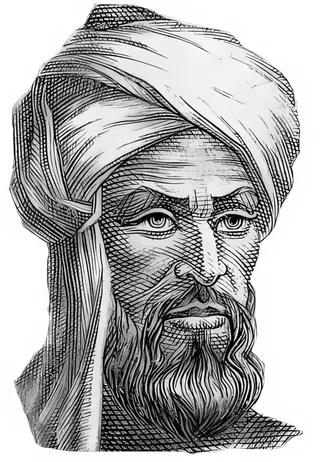Islamic Golden Age: From Geometric to Algorithmic Mean Calculations
Building on Greek geometric understanding of means through music and proportion, Islamic mathematicians made a revolutionary shift to systematic calculation methods. At Baghdad's House of Wisdom (Bayt al-Hikma), they transformed mean calculations from geometric constructions into step-by-step procedures - creating the foundation for algorithmic mathematics.
Key Innovations in Mean Calculation
Al-Khwarizmi transformed Greek geometric methods into computational procedures. Instead of constructing means with compass and ruler, he introduced systematic steps using the new Hindu-Arabic decimal system. This made calculating means faster and more practical for everyday use.
Algorithmic Methods:
1. Arithmetic Mean (حساب الوسط)
Step-by-step addition and division, replacing geometric bisection
2. Geometric Mean (الوسط الهندسي)
Multiplication and root extraction, replacing circle construction
Early Weighted Mean Development
Al-Karaji developed an early form of weighted averaging for inheritance calculations. Unlike modern weighted means that use arbitrary weights, his system used fixed proportional shares based on Islamic law. This work laid the groundwork for later development of general weighted means.
Example: Inheritance Division
Estate: 1000 dinars
Shares: 2:1:1 ratio
Calculation:
Total parts = 4
Value per part = 1000 ÷ 4
Distribution by share size
Legacy and Transition to Modern Mathematics
The Islamic mathematicians bridged ancient geometric and modern computational approaches to means. While they didn't develop statistical theory (which came centuries later), their systematic calculation methods transformed how we work with averages:
Their Innovations:
- • First systematic calculation procedures
- • Use of decimal arithmetic for means
- • Early forms of weighted averaging
- • Integration with practical applications
Differences from Modern Methods:
- • No statistical theory or probability
- • Limited to exact calculations
- • Fixed rather than variable weights
- • No sampling or estimation theory
Their greatest contribution was transforming means from geometric concepts into computational procedures. The term "algorithm" itself derives from Al-Khwarizmi's name, reflecting their fundamental impact on mathematical calculation methods.
Astronomical Applications
Al-Biruni revolutionized astronomical calculations by applying means to planetary observations. He developed methods to find average planetary positions that remained accurate over centuries:
Mean Motion = (θ₂ - θ₁) ÷ (t₂ - t₁)
Where:
θ₂, θ₁ = planet positions
t₂, t₁ = observation times
This method achieved accuracy within 1° over 1000 years

Practical Innovations
Introduction of decimal arithmetic and systematic procedures made mean calculations accessible for practical use in trade, astronomy, and architecture.
Development of proportional distribution systems for inheritance and trade using early forms of weighted averaging.
Application of geometric means in architecture and surveying, with new computational methods replacing physical construction.
Historical Significance
The Islamic Golden Age transformed theoretical understanding of means into practical computational methods. Scholars systematized calculation procedures, developed algebraic approaches to mean computation, and created the algorithmic foundation for modern mathematical computation.
The term "algorithm" itself, derived from Al-Khwarizmi's name, reflects this period's enduring contribution to systematic calculation methods. Their work preserved and enhanced Greek mathematical knowledge while adding crucial innovations in computational methodology that influenced mathematical practice for centuries to come.